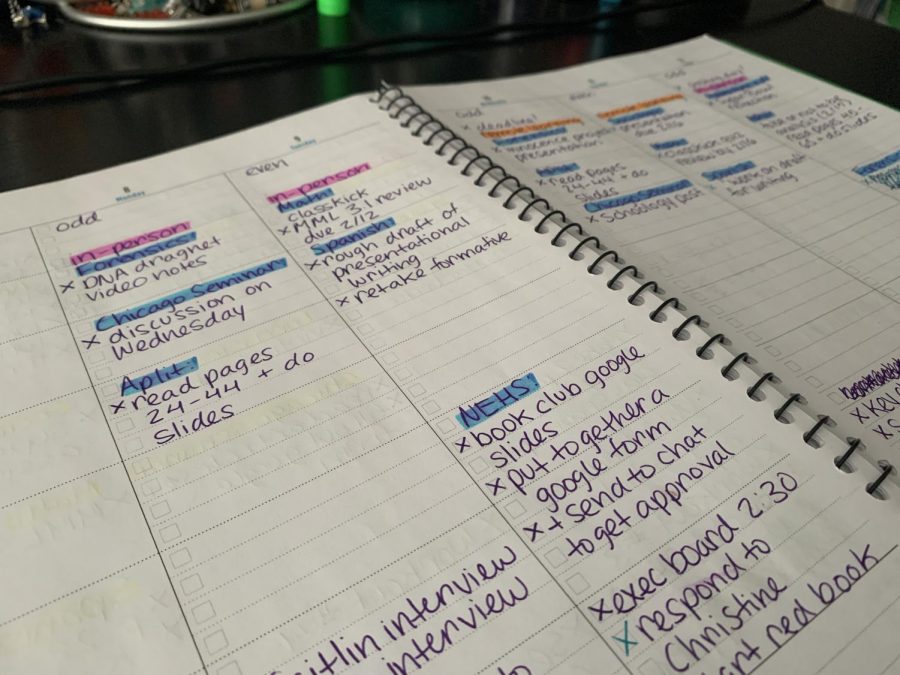Staff Editorial: The Problem With Homework
A calendar showing the amount of homework for just one week
February 19, 2021
Wake up anytime from 5:00 to 7:21, drive or login to school, be there for five hours, hear the bell ring, do our homework and attend practices and meetings until we go to sleep–this is the life of many high school students right now.
Using the words “monotonous” or “draining” to describe this experience would be an understatement.
Granted, this series of events isn’t that unlike what we normally do. However, before COVID-19 went and troubled these times, we felt we were assigned less homework.
This year, compared to previous ones, we think that teachers are giving us more work that seems, to us, to have no purpose.
For instance, assigning a worksheet that is only graded for completion and isn’t gone over in class means that we don’t understand its contribution to our learning.
An easy way of avoiding this is for the teachers and students to work together.
Teachers: think about the purpose of the assignment and encourage your students to inquire when they may miss it.
Students: ask when you are unsure of an assignment’s purpose.
People, parents especially, are very concerned about what their children are learning in school; they are wondering if their children are learning enough. This concern is part of the reason the district opted to add five minutes to each class period.
We also think that the block schedule is a contributing factor. Because we alternate seeing our teachers, we believe that teachers are assigning us this work to try and make up for the lost day.
In theory, we work ahead on our homework by doing it the same day it is assigned, but students seldom do this.
The block schedule has allowed us to feel more like college students.
In college, work isn’t due immediately after it’s assigned, so in that regard, we are getting a nice trial run. We are following our own schedule, helping us feel more independent.
A possible solution to this homework problem is opening the line of communication between students and teachers, an example of which is seen above. Having a teacher ask students to report, in an anonymous fashion, how they feel about the workload and adjust as needed would mean the world to students.
Teachers making a calendar detailing what homework will be due when is another possibility. This method could mean that students would have the option to work ahead on their assignments, allowing them to more accurately control their schedules like college students.
Because we are in a pandemic, we feel that students should be getting less homework. This past year has been traumatizing for everyone, and we think that the last thing students need is to be overwhelmed every night. In our opinion, we should spend more time caring for ourselves, not doing worksheet after worksheet.
In 2014, a Stanford researcher conducted a study of 4,317 students from ten high-performing high schools in Californian upper-middle-class communities about the effects of homework.
The study went on to conclude that “56 percent of the students considered homework a primary source of stress, according to the survey data. Forty-three percent viewed tests as a primary stressor, while 33 percent put the pressure to get good grades in that category.”
To quote both the study and Denise Pope, a senior lecturer at the Stanford Graduate School of Education and a co-author of a study published in the Journal of Experimental Education, “The findings address how current homework practices in privileged, high-performing schools sustain students’ advantage in competitive climates yet hinder learning, full engagement, and well-being.”
That study was conducted seven years ago, during precedented times, so imagine how Covid-19 plays into those numbers. Mental health and overall morale are all being negatively affected by the pandemic. This results in low motivation and an apathetic attitude, making the homework assigned seem more like demanding and laborious tasks.
Homework is an accepted part of American schooling: it’s a fact that isn’t going away anytime soon.
However, how the homework is handled can be changed. Teachers and students need to work together on this issue in order to make the remainder of the school year better for all.
The purpose of the staff editorial is to start a conversation. The editorial topic and stance are discussed and agreed on by all members of the editorial board. While only one editor writes the article and the editorial may not represent each editor’s opinion 100%, it does represent an editorial consensus. Again, the purpose is discussion. Let us know what you think through Twitter @SCNNewspaper and email at [email protected].



